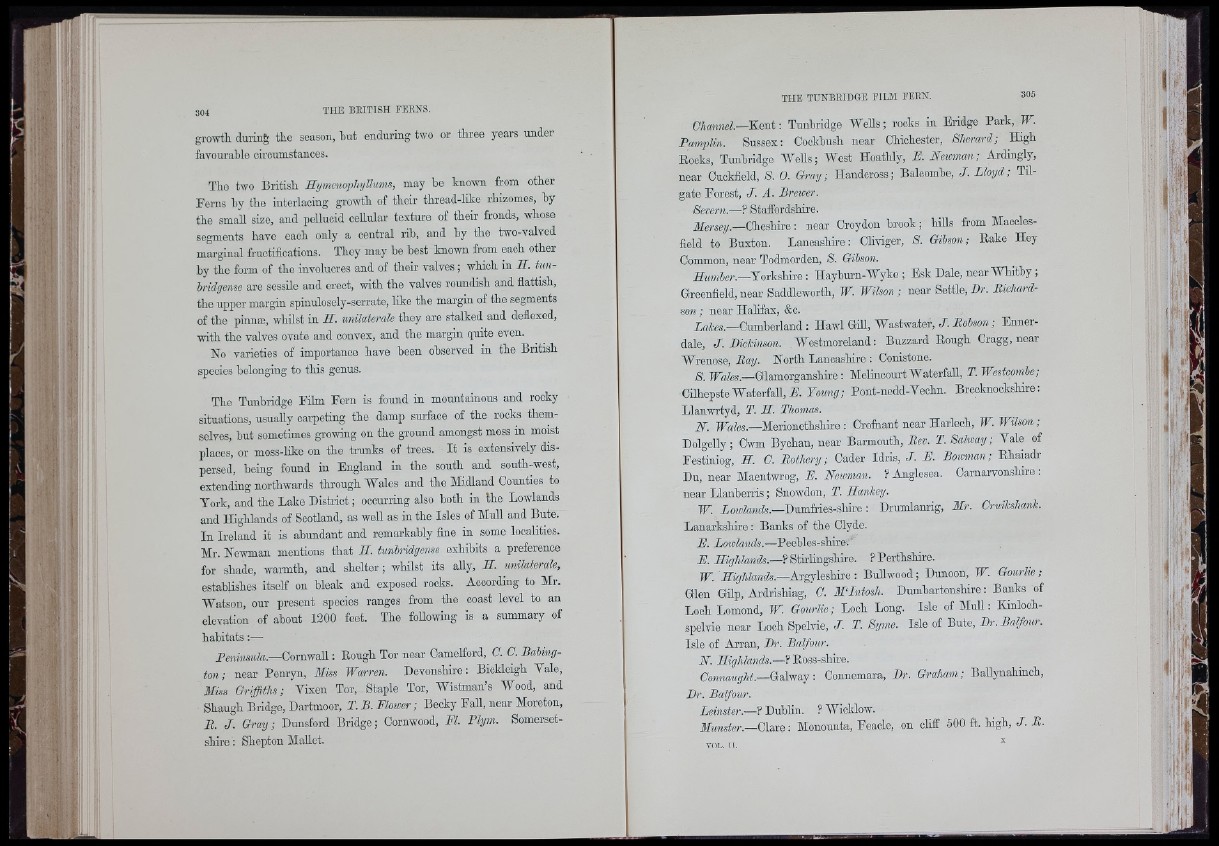
304 THE BKITISH EERNS,
growth during the season, but enduring two or three years under
favourable ciroumstances.
Tho two British Hijmmoplujllmns, may he known from other
Ferns hy the interlaoing growth of thoir thread-like rhizomes, by
the small size, and pellucid cellular texture of their fronds, whose
segments have each only a central rib, and hy the two-valved
marginal fructifications. They may be best known from each other
by tho form of the involucres and of their valves ; which in II. tun-
bridgense are sessile and erect, with the valves roundish and flattish,
the upper margin spinulosely-serrate, like the margin of the segments
of the pinnæ, whilst in II. unilaterale they are stalked and deflexed,
with the valves ovate and convex, and the margin quite even.
No varieties of importance have been observed in the British
species belonging to this genus.
The Tunbridge Film Fern is found in mountainous and rocky
situations, usually carpoting the damp surface of the rocks themselves,
hut sometimes growing on the ground amongst moss in moist
places, or moss-hlce on the trunks of trees. It is extensively dispersed,
being found in England in the south and south-west,
extending northwards through Wales and the Midland Counties to
York, and the Lake District ; ooourring also both in the Lowlands
and Highlands of Scotland, as weU as in the Isles of Mull and Bute.
In Ireland it is abundant and remarkably fine in some localities.
Mr. Newman mentions that 3 . tunbridgense exhibits a preference
for shade, warmth, and shelter ; whilst its ally, II. unilaterale,
establishes itself on bleak and exposed rooks. According to Mr.
Watson, our present species ranges from the coast level to an
elevation of about 1200 feet. The foUowing is a summary of
habitats :—
Peninsula.—Cornwall ; Eough Tor near Camelford, C. C. Babing-
ton; near Penryn, Miss Warren. Devonshire: Bickleigh Vale,
Mils Griffiths; Vixen Tor, Staple Tor, Wistman’s Wood, and
Shaugh Bridge, Dartmoor, I . B. Ploicer ; Becky Fall, near Moreton,
B. J. Gray; Dunsford Bridge; Cornwood, PL Plym. Somersetshire
: Shepton Mallet.
Channel.—Kent: Tunbridge WeUs; rocks in Eridge Park, W.
Pamplin. Sussex: CookbusU near CUicUester, Sherard; High
Rooks, Tunbridge Wells; West Iloathly, P. Newman; Ardingly,
near Cuckfield, S. 0. Gray; Handoross; Baloombe, J. Lloyd; Tilgate
Forest, J. A. Brewer.
Severn.—? Staffordshire.
Mersey.—Cheshire: near Croydon brook; hills from Macclesfield
to Buxton. Lancashire: Cliviger, S. Gibson; Rake Hey
Common, near Todmorden, S. Gibson.
Humber.—YorkMm: Hayburn-Wyke ; Esk Dale, near IVhitby ;
Greenfield, near Saddleworth, W. Wilson ; near Settle, Br. Richardson
; near Halifax, &o.
ia/ies.—Cumberland : Hawl Gill, Wastwater, J. Robson; Enner-
dale, J. Bickinson. Westmoreland: Buzzard Rough Cragg, uear
Wrenose, Ray. North Lancashire : Conistone.
8. Fafes.—Glamorganshire: Melincourt Waterfall, I . Westcombe;
Cilhepste Waterfall, F. Young; Pont-nedd-Yechn. Brecknockshire:
Llanwrtyd, I . H. Ihomas.
N. Wales.—Merionethshire : Crofnant near Harlech, W. Wilson;
Dolgolly; Civm Byohan, near Barmouth, Rev. I . Salway; Yale of
Festiniog, II. G. Rothery; Cader Idris, J. P. Boicman; Rhaiadi’
Du, near Maentwrog, P. Newman. ? Anglesea. Carnarvonshire :
near Llanberris; Snowdon, I . Hankey.
W. ioic/iwrfs.—Dumfries-shire : Drumlanrig, Mr. Cruikshank.
Lanarkshire : Banks of the Clyde.
E. Loio/anrfs.—Peehles-shire.'
£■. StirUngshire. ? Perthshire.
W. Highlands.—Yrg-fieiikm : BuUwood; Dunoon, W. Gourlie;
Glen GUp, Ardrishiag, C. MAntosh. Dumbartonshire: Banks of
Loch Lomond, W. Gourlie; Loch Long. Isle of Mull: Kinlooh-
spolvie near Loch Spelvie, J. I . Syme. Islo of Bute, Br. Balfour.
Isle of Arran, Br. Balfour.
N. Highlands.-—? Ross-shire.
Connaught.—Galway : Connemara, Br. Graham; Ballynahinoh,
Br. Balfour.
Leinster.—? Dublin. ? Wicldow.
Munster.—^Clai’e : Monounta, Feaole, on cliff 500 ft. high, J. Riii
'if
■ i.l- .11
i
■
t'-'-
( ¥ 6
H I
i - i
•?’ .1
' I 1
;i ».
ii'ri
* • 5 •'
"■#1
iii'î.'è